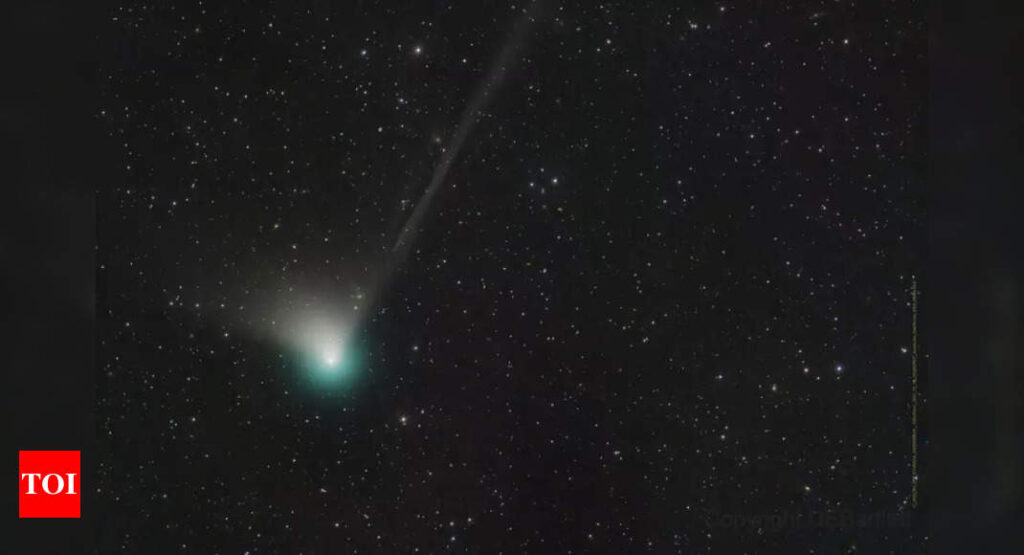50,000 years on, ‘green comet’ comes visiting again – Times of India

JAIPUR: Comet C/2022 E3 (ZTF), popularly known as the “green comet“, which last visited Earth’s neighbourhood 50,000 years ago when the Neanderthals were still roaming its surface, can now be viewed in India with a pair of binoculars from a dark location.
It may further brighten in the next few days and become visible to the naked eye as it makes its closest pass of the Earth on February 2.
TOI captured pictures of this rare visitor – among the first camera images of the comet in India – from the dark skies of Sambhar Lake in Jaipur early Saturday morning, using a camera and a star tracker. The comet appears distinctly green with a characteristic fuzzy coma and a faint hint of a tail.
As per watchers from other parts of the world, C/2022 E3 is now regularly being reported to be just brighter than magnitude +6, which technically makes it a naked-eye object. Its naked-eye visibility, though, is still likely to be restricted to extremely dark places under good conditions. This may change in the next few days. At present, from reasonably dark rural locations, the comet can be easily viewed as a greenish fuzzy object with a pair of binoculars.
The visitor can be spotted above the northern horizon. Over the next few days, its location will be between the Pole Star (Polaris) and the Great Bear (Ursa major, or Sapt Rishi) constellation. Since moonlight makes sky objects fainter, the best time to view it is in the early morning hours after moonset. The brightness of comets is difficult to predict but this one is expected to be the brightest of 2023.
C/2022 E3 (ZTF) was discovered by astronomers Bryce Bolin and Frank Masci using the Zwicky Transient Facility (ZTF) survey on 2 March 2022. Long-period comets like C/2022 E3 are believed to come from the outermost realms of our Solar System, a vast frigid zone called the Oort Cloud.
The green comet isn’t expected to be anywhere as spectacular as shiny tailed “great comets”, several of which have been bright enough to be seen in daylight. The last such object was Comet McNaught in 2007. However, it’s still a fascinating visitor to our skies and won’t likely be seen again for 50,000 years.
It may further brighten in the next few days and become visible to the naked eye as it makes its closest pass of the Earth on February 2.
TOI captured pictures of this rare visitor – among the first camera images of the comet in India – from the dark skies of Sambhar Lake in Jaipur early Saturday morning, using a camera and a star tracker. The comet appears distinctly green with a characteristic fuzzy coma and a faint hint of a tail.
As per watchers from other parts of the world, C/2022 E3 is now regularly being reported to be just brighter than magnitude +6, which technically makes it a naked-eye object. Its naked-eye visibility, though, is still likely to be restricted to extremely dark places under good conditions. This may change in the next few days. At present, from reasonably dark rural locations, the comet can be easily viewed as a greenish fuzzy object with a pair of binoculars.
The visitor can be spotted above the northern horizon. Over the next few days, its location will be between the Pole Star (Polaris) and the Great Bear (Ursa major, or Sapt Rishi) constellation. Since moonlight makes sky objects fainter, the best time to view it is in the early morning hours after moonset. The brightness of comets is difficult to predict but this one is expected to be the brightest of 2023.
C/2022 E3 (ZTF) was discovered by astronomers Bryce Bolin and Frank Masci using the Zwicky Transient Facility (ZTF) survey on 2 March 2022. Long-period comets like C/2022 E3 are believed to come from the outermost realms of our Solar System, a vast frigid zone called the Oort Cloud.
The green comet isn’t expected to be anywhere as spectacular as shiny tailed “great comets”, several of which have been bright enough to be seen in daylight. The last such object was Comet McNaught in 2007. However, it’s still a fascinating visitor to our skies and won’t likely be seen again for 50,000 years.







